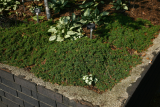Additional notes (click to expand)
Horticulture
A hardy, coniferous, evergreen, trailing, prostrate shrub with bright green leaves, to 30cm (12in) tall by 2m (6ft) wide. The small, spherical fruits, borne on the female plants, are green at first, and take two years to ripen to blue-black. Contact with the foliage may aggravate skin allergies.
Grow in any well-drained soil, including, dry, chalky, or sandy soils, preferably in full sun or in light dappled shade. Junipers need little, if any, pruning.
To propagate- remove seed from flesh as soon as ripe and sow in containers in a cold frame; germination may take up to 5 years. Root ripe-wood cuttings in early autumn.
Prone to twig blight, aphids, scale insects, webber moth caterpillars, and honey fungus.
Brickell, C. (2003). A-Z Encyclopedia of Garden Plants. Dorling Kindersley. p.590
Medicinal
The berries are not given to patients with kidney disease, or to pregnant women, as they are a uterine stimulant.
The berries of J. communis have antiseptic, anti-inflammatory and digestive properties and are thought to be helpful for rheumatism, gout, arthritis and colic.
Traditional Herbal Medicine Registration (THMR).
Prescription only medicine: Taxanes.
Nomenclature
communis- common, general, growing in company.
Stearn, W.T. (1996). Dictionary of Plant Names for Gardeners. Cassell. p.101
From biblical times Juniperus has symbolised protection, and there are many references to people using it for shelter.
‘Elijah went a day’s journey into the wilderness and came and sat down under a juniper tree’ (I King 19:4).
Bird, R, Houdret, J. (2000). Kitchen and Herb Gardener. Lorenz. p.400
Other use
In medieval Europe a fire of juniper wood was burned to discourage evil sprits and protect from plague. It was thought that felling a tree would bring death in the family within a year. J. communis’ medicinal properties were recorded by ancient Greek and Roman physicians. Culpeper recommended it, among many other uses, as “a counter-poison, resister of the pestilence and excellent against the biting of venomous beasts”. It is famous as a flavouring ingredient in gin- the English word being an abbreviation of “Holland’s Geneva” as gin was first known, from the Dutch word for juniper, jenever. This is a traditional alcoholic drink of the Netherlands and Belgium, from which gin evolved. It became popular in the United Kingdom when William of Orange, leader of the Dutch Republic, occupied the English and Scottish thrones with his wife Mary.
Bird, R, Houdret, J. (2000). Kitchen and Herb Gardener. Lorenz. p.400
Used to flavour gin. Oil is used in cosmetics and perfumery. In a culinary capacity, Juniper is added to pickles, chutneys, sauces, marinades, meat and game dishes, pâtés and sauerkraut.
Its perfume ‘driveth away serpents’. Some people to prevent being stung by serpents ‘rub or anoint their bodies with a liniment made from Juniper seed or berries’. Seeds and berries used in antidotes to poisons, against stomach and chest pains, coughs, wind and swellings ‘tumours’. Berries in wine against convulsions, cramps, ruptures, colic, uterine pain and sciatica. Diuretic.
Pliny Secundus (1634) Natural Historie , trans by Philemon Holland, Book 2 page 186
Geographical distribution
- Africa, Northern Africa
- Asia-Temperate
- Asia-Tropical
- Europe
- Northern America
Juniperus communis L. 'Green Carpet'
Family: CUPRESSACEAEGenus: Juniperus
Species: communis L.
Cultivar: 'Green Carpet'
Pharmacopoeia Londinensis name: Iuniperus
Distribution summary: Garden origin
Habit: Shrub
Hardiness: H5 - Hardy; cold winter
Garden status: Currently grown
Garden location: Plants of the World (D)
Flowering months: May, June
Reason for growing: Medicinal, other use, prescription only medicine
.jpg)

.jpg)